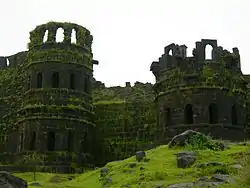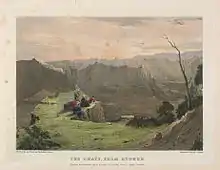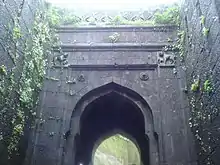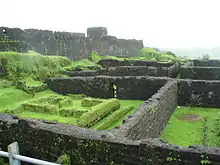Raigad Fort
Raigad is a hill fort situated in Mahad, Raigad district of Maharashtra, India. It is one of the strongest fortresses on the Deccan Plateau.[1]
| Raigad Fort | |
|---|---|
| Raigad District, Maharashtra (near Mahad) | |
 Raigad Fort towers | |
 Raigad Fort Shown within Maharashtra  Raigad Fort Raigad Fort (India) | |
| Coordinates | 18°14′01″N 73°26′26″E |
| Type | Hill fort |
| Height | 1,356 metres (4,400 ft) ASL |
| Site information | |
| Owner |
|
| Open to the public | Yes |
| Site history | |
| Built by | Hirojee Indulkar |
| Materials | Stone, Lead |
| Garrison information | |
| Past commanders | Chatrapati Shivaji Maharaj, Chatrapati Sambhaji Maharaj |
| Occupants | Dharmvir Chatrapati Sambhaji Maharaj |
Many constructions and structures on Raigad were built by Chhatrapati Shivaji Maharaj when he made it his capital in 1674 upon being crowned the King of the Maratha Kingdom, which later developed into the Maratha Empire, eventually covering much of western and central India.[2] In 1765, the fort was the location of an armed campaign by the British East India Company. Finally, on 9 May 1818, the fort was looted and destroyed by the British.
The fort rises 820 metres (2,700 ft) above sea level in the Sahyadri mountain range. There are approximately 1,737 steps leading to the fort. The Raigad Ropeway, an aerial tramway, reaches 400 meters in height and 750 meters in length, and allows visitors to reach the fort from the ground in only four minutes.
History

Chatrapati Shivaji Maharaj seized the fort in 1656, then known as the fort of Rairi from Chandraraoji More, The King of Jawali. Shivaji renovated and expanded the fort of Rairi and renamed it as Raigad (King's Fort). It became the capital of Chhatrapati Shivaji's Maratha Empire.
The villages of Pachad & Raigadwadi are located at the base of the Raigad fort. These two villages were considered very important during the Maratha rule in Raigad. The actual climb to the top of the Raigad fort starts from Pachad. During Chatrapati Shivaji's rule, A cavalry of 10,000 was always kept on standby in Pachad village. Shivaji also built another fort Lingana around 2 miles away from Raigad. The Lingana fort was used to keep prisoners.
In 1689, Zulfikhar Khan captured Raigad and Aurangzeb renamed it as Islamgad. In 1707, Siddi Fathekan captured the fort and held it until 1733. After 1733 maratha sardar captured raigad again and hold it until 1818.[3]
In 1765, The fort of Raigad along with Malwan in present Sindhudurg District, the southernmost district of Maharashtra, was the target of an armed expedition by the British East India Company, which considered it a piratical stronghold.
In 1818, the fort was bombarded and destroyed by cannons from the hill of Kalkai. And on 9 May 1818, as per the treaty, it was handed over to the British East India Company.
Major features


The Raigad Fort was built by Chhatrapati Shivaji Maharaj and the chief architect/engineer was Hiroji Indulkar. The main palace was constructed using wood, of which only the base pillars remain. The main fort ruins consist of the queen's quarters, six chambers, with each chamber having its own private restroom. In addition, ruins of three watch towers can be seen directly in front of the palace grounds out of which only two remain as the third one was destroyed during a bombardment. The Raigad Fort also has ruins of a market which was accessible to horseback riders. The fort also overlooks an artificial lake known as the Ganga Sagar Lake.
The only main pathway to the fort passes through the "Maha Darwaja" (Huge Door) which was previously closed at sunset. The Maha Darwaja has two huge bastions on both sides of the door which are approximately 65–70 feet in height. The top of the fort is 600 ft above this door.
The King's Darbar, inside the Raigad Fort has a replica of the original throne that faces the main doorway called the Nagarkhana Darwaja. This enclosure had been acoustically designed to aid hearing from the doorway to the throne. A secondary entrance, called the Mena Darwaja, was supposedly the private entrance for the royal ladies of the fort that lead to the queen's quarters. The convoy of the king and the king himself used the Palkhi Darwaja. To the right of Palkhi Darwaja, is a row of three dark and deep chambers. Historians believe that these were the granaries for the fort.[4]
From the fort, one can view the execution point called Takmak Tok, a cliff from which sentenced prisoners were thrown to their death. This area has been fenced off.[5]
The statue of Chatrapati Shivaji is erected in front of the ruins of the main market avenue that leads to the Jagdishwar Mandir and his own Samadhi and that of his loyal dog named Waghya. The Samadhi of Jijabai,Chatrapati Shivaji's mother, can be seen at base village of Pachad.
Additional famous attractions of the fort include the Khubladha Buruj, Nane Darwaja and the Hatti Talav (Elephant Lake).
Hirakani Buruj
The fort has a famous wall called "Hirakani Buruj" (Hirakani Bastion) constructed over a huge steep cliff. The legend goes "that a woman by the name of Hirakani from a nearby village had come to sell milk to the people living at the fort. She happened to be inside the fort when the gates got closed and locked at sunset. Hearing the cries of her infant son back at the village echo after nightfall, the anxious mother couldn't wait till dawn and courageously climbed down the steep cliff in pitch darkness all for the love of her little one. She later repeated this extraordinary feat in front of Shivaji and was bravely rewarded for it." In appreciation of her courage and bravery, Shivaji built the Hirakani Bastion over this cliff.
Incidents
- The statue of Shivaji's pet dog was removed by alleged members of the Sambhaji Brigade[6] in July 2012 as a protest but was re-instated by Shri Shivaji Raigad Smarak Samiti, the Archaeological Survey of India, sculptor Rambhau Parkhi and the District Administration[7]
Gallery


 Raigad 1896
Raigad 1896 Hidden Walls of the Raigad Fort
Hidden Walls of the Raigad Fort Raigad Fort Palace Ruins
Raigad Fort Palace Ruins
References
- Here's why you should visit Raigad fort:https://timesofindia.indiatimes.com/travel/destinations/this-is-why-you-should-visit-maharashtras-raigad-fort/as65783005.cms
- "Raigarh". Imperial Gazetteer of India, Volume 21. 1909. pp. 47–48. Retrieved 19 February 2014.
- Naravane, M.S. (1998). The maritime and coastal forts of India. New Delhi: APH Pub. Corp. p. 61. ISBN 9788170249108.
- Write-up from the Raigad ropeway
- Gunaji, Milind (2005). Offbeat Tracks in Maharashtra. Popular Prakashan. p. 41. ISBN 81-7154-669-2. Retrieved 17 March 2009.
- "73 held for removing Shivaji's dog's statue from Raigad fort". DNA. Retrieved 4 August 2012.
- "Vaghyacha putala punha basavala". Sakal. Retrieved 4 August 2012.
External links
| Wikimedia Commons has media related to Raigad Fort. |